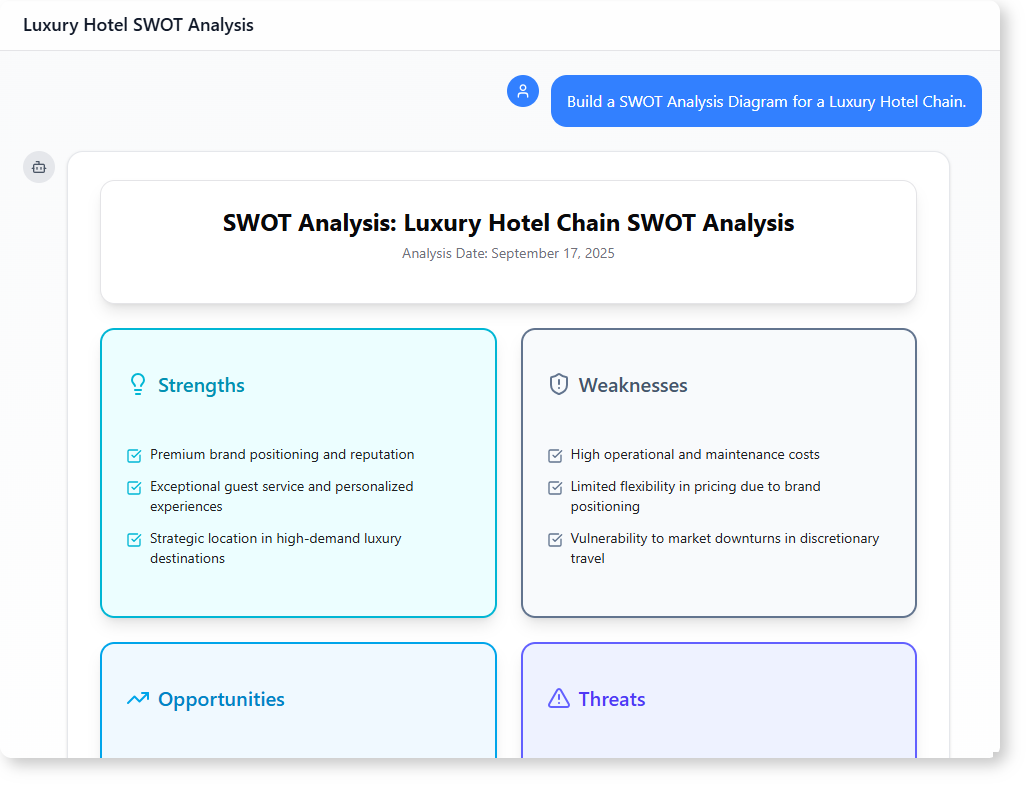Now Reading: How to Generate a SWOT Analysis for a Luxury Hotel Chain with AI-Powered Modeling Software
-
01
How to Generate a SWOT Analysis for a Luxury Hotel Chain with AI-Powered Modeling Software
How to Generate a SWOT Analysis for a Luxury Hotel Chain with AI-Powered Modeling Software
Why a SWOT Analysis Matters for Luxury Hotels
A luxury hotel isn’t just about rooms and views. It’s about perception, experience, and long-term positioning. That’s why a well-structured SWOT analysis is essential.
For a luxury hotel chain, understanding internal strengths and weaknesses, as well as external opportunities and threats, helps shape strategy. Without this clarity, decisions on pricing, expansion, or brand messaging can miss the mark.
That’s where AI-powered modeling software comes in. It doesn’t just generate diagrams — it understands context, delivers tailored insights, and turns abstract business questions into clear, actionable frameworks.

A Real-World Use Case: A Hotel Executive Needs Strategic Clarity
Imagine a hotel executive who’s planning the next phase of growth. They want to assess the current state of their brand — not just what’s working, but what’s under pressure.
They don’t have time to manually research competitors or build a SWOT diagram from scratch. They need something fast, accurate, and grounded in real-world context.
Their goal? To build a SWOT analysis for a luxury hotel chain that reflects current market dynamics — especially around sustainability, traveler behavior, and brand positioning.
This isn’t just about listing pros and cons. It’s about turning strategic thinking into a visual, shareable format that stakeholders can understand at a glance.
How the AI-Powered Modeling Software Helped
The process took just three steps:
-
The Prompt: The user asked, ‘Build a SWOT Analysis Diagram for a Luxury Hotel Chain.’
The AI interpreted the request, recognized the domain (luxury hospitality), and applied industry-specific insights. It didn’t guess — it generated a structured, balanced SWOT based on real-world trends in the luxury travel market.
-
The Output: The AI returned a clean, readable SWOT diagram with four clear sections:
-
Strengths: Premium brand positioning, personalized guest experiences, and prime location.
-
Weaknesses: High operational costs, rigid pricing, and vulnerability during economic downturns.
-
Opportunities: Rising demand for wellness stays, expansion into eco-luxury, and influencer partnerships.
-
Threats: Rising competition from boutique brands, economic instability, and climate risks to coastal sites.
Each point was contextualized — not just a bullet, but a reflection of actual market pressures.
-
The Follow-Up: The user then asked, ‘Prepare a written guide that walks through the diagram step by step.’
The AI didn’t stop at the diagram. It provided a clear, educational breakdown — explaining how each strength or threat connects to business strategy. It explained why operational costs matter, how influencer partnerships could grow reach, and what climate risks might affect future site selection.
This level of detail shows the software isn’t just generating content — it’s delivering insight.
What Makes This AI Modeling Tool Different?
Most tools offer a blank canvas or basic templates. This one understands context.
It knows that a luxury hotel isn’t just a place to stay — it’s a brand built on exclusivity, service, and experience. So when generating a SWOT, it doesn’t just list factors. It weighs them.
For example:
- It identifies that high maintenance costs are a weakness — not because of cost, but because they limit flexibility.
- It flags climate change not as a vague risk, but as a direct threat to high-value coastal locations.
This isn’t random output. It’s intelligent analysis built into the modeling process.
The Power of a SWOT Diagram Generator in Action
A SWOT diagram generator doesn’t just draw boxes. It helps stakeholders see the full picture — what’s working, what’s holding back growth, and where opportunities lie.
In this case, the diagram helped the hotel team:
- Recognize that their brand strength in service could be leveraged in new wellness offerings.
- Understand that their location is a strength but also a vulnerability due to climate risks.
- See that partnerships with influencers could be a low-cost way to drive awareness.
These insights wouldn’t have been visible in a spreadsheet or a simple report.
Why This Is a Better Approach to Business Strategy
Traditional SWOT analysis tools often rely on manual input. This approach removes friction — the user doesn’t need to know modeling syntax or domain jargon.
Instead, they simply describe the situation, and the AI-powered modeling software interprets it and delivers a structured, insightful analysis.
It works best when used for real-world planning — not as a classroom exercise.
Frequently Asked Questions
What is the difference between a SWOT analysis tool and an AI-powered modeling software?
A SWOT analysis tool is a basic framework for evaluating a business. An AI-powered modeling software goes beyond that — it understands context, applies domain knowledge, and delivers tailored, strategic insights.
Can I use this to generate a SWOT analysis for any industry?
Yes. The AI is trained to recognize patterns in different sectors. Whether it’s hospitality, tech, or retail, it can generate relevant, industry-specific SWOT analysis.
Is the SWOT analysis generated by the AI based on real-world data?
The analysis reflects current industry trends and market dynamics. While it doesn’t pull live data, it is grounded in real-world observations about consumer behavior, competition, and environmental factors.
How do I interpret the SWOT output for strategic planning?
Look at the connections between strengths and opportunities. For example, a hotel’s strong service reputation can be matched with a wellness offering. Weaknesses should prompt questions about process or flexibility. Use the threats to anticipate risks before they happen.
Ready to map out your system’s interactions? Give our AI-powered modeling software a try at Visual Paradigm’s AI Chatbot today!
